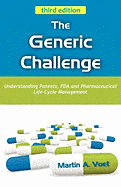“The pharmaceutical industry is trashed nightly as being second only to the tobacco industry in the corporations-we-hate-most department.”
~ Martin Voet

This Third Edition comes with updates on new case law, materials on the interaction of Section 8 skinny labeling and patent use codes, a new section on biosimilars and a new, actual example of life-cycle management.
A Section 8 ANDA is an Abbreviated New Drug Application (ANDA) filing with labeling omitting an approved, but patented, indication. Thus, it enables the ANDA filers to not have to provide Paragraph IV certification and are not entitled to the first-filer, 180-day exclusivity. This is the so-called “skinny” labeling or “carve out” filing. The Section viii certification may only be approved if the composition patents covering the reference listed drug have expired, or will expire, prior to the date of the proposed marketing and sale of the generic drug. In addition, there must be no overlap between the proposed carve-out label and the use code narrative submitted by the patentee or “innovator” manufacturer.
Proving inducement of infringement in an ANDA case is often difficult for innovator pharmaceutical companies. Indeed, proof of inducement “requires evidence of culpable conduct, directed to encouraging another’s infringement.” Such evidence may be found in the ANDA applicant’s proposed labeling, which might instruct physicians that the drug is indicated for a particular (patented) use.
Because a Section 8 statement potentially allows an ANDA filer to obtain approval of a generic drug without delay, it is of great interest to both innovator and generic companies. In addition, physicians routinely prescribe generic drugs as a substitute for name brand medications, and some physicians will also prescribe such generics for off-label and patented methods of use.
While not intended to replace competent legal counsel, this concise little guide is intended for the busy executive to learn these subjects in understandable language so that you will be able to ask the right questions and understand the answers you receive. Broad in coverage, the book covers patent enforcement and infringement, pharmaceutical product life-cycle management, regulatory matters, and legislation related to pharmaceuticals with Take Home Messages at the end of each chapter summarizing the main points.
We highly recommend it.
About the Author
Martin A. Voet is a Senior Vice President and Chief Intellectual Property Counsel for Allergan.
The Generic Challenge: Understanding Patents, FDA and Pharmaceutical Life-Cycle Management (third edition) is available at Amazon.

Extraordinarily beneficial many thanks, It is my opinion your followers may very well want a whole lot more writing such as this continue the good hard work.